Identifying Entrepreneurial Opportunities
VerifiedAdded on 2023/01/12
|15
|3089
|64
AI Summary
This assignment focuses on identifying entrepreneurial opportunities and market gaps. It covers the rationale and market gap for a specific idea, data analysis to support gap analysis, interpretation of data, and the use of SWOT analysis for idea assessment. The assignment also evaluates the environments in which the idea will be launched to assess its viability.
Contribute Materials
Your contribution can guide someone’s learning journey. Share your
documents today.
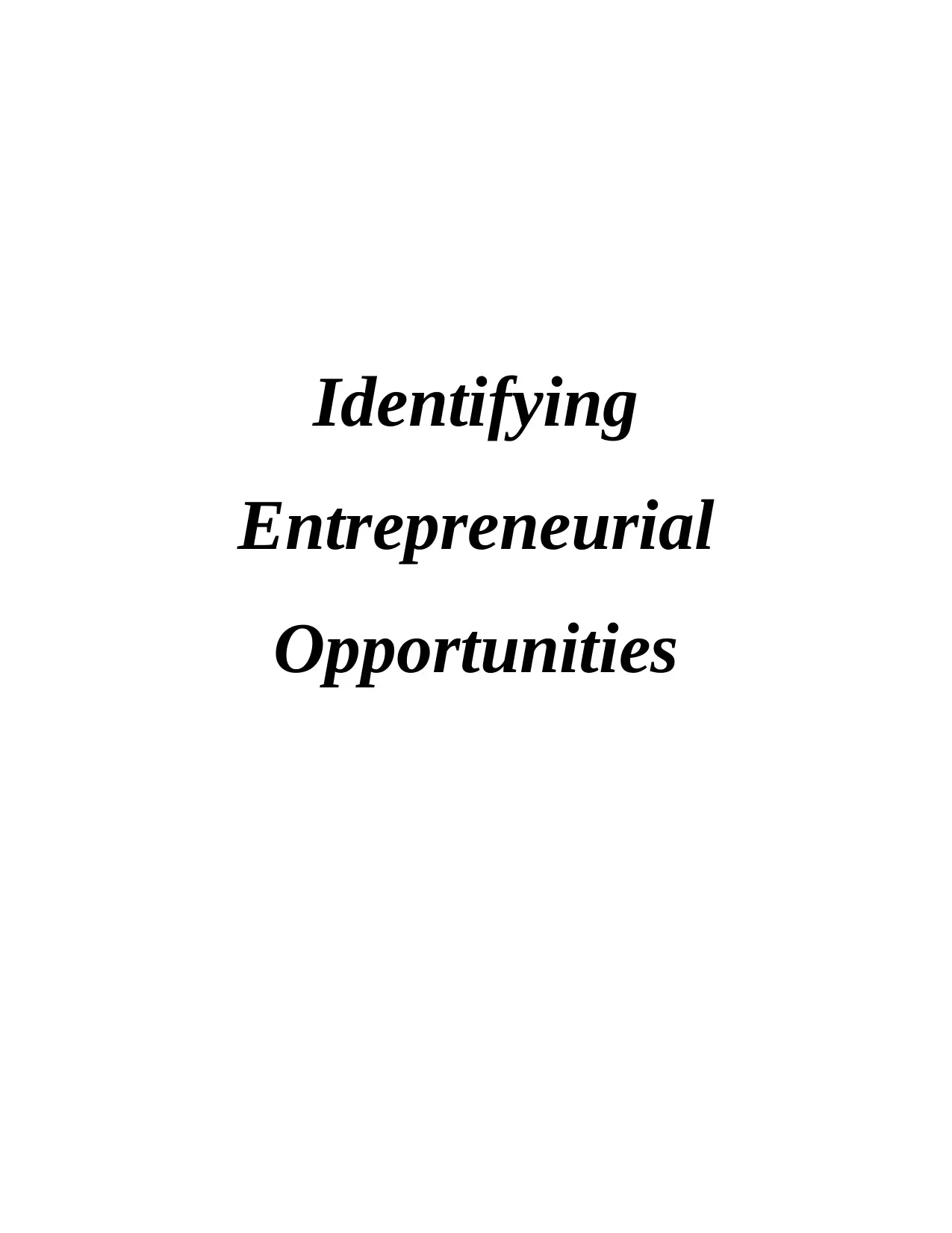
Identifying
Entrepreneurial
Opportunities
Entrepreneurial
Opportunities
Secure Best Marks with AI Grader
Need help grading? Try our AI Grader for instant feedback on your assignments.
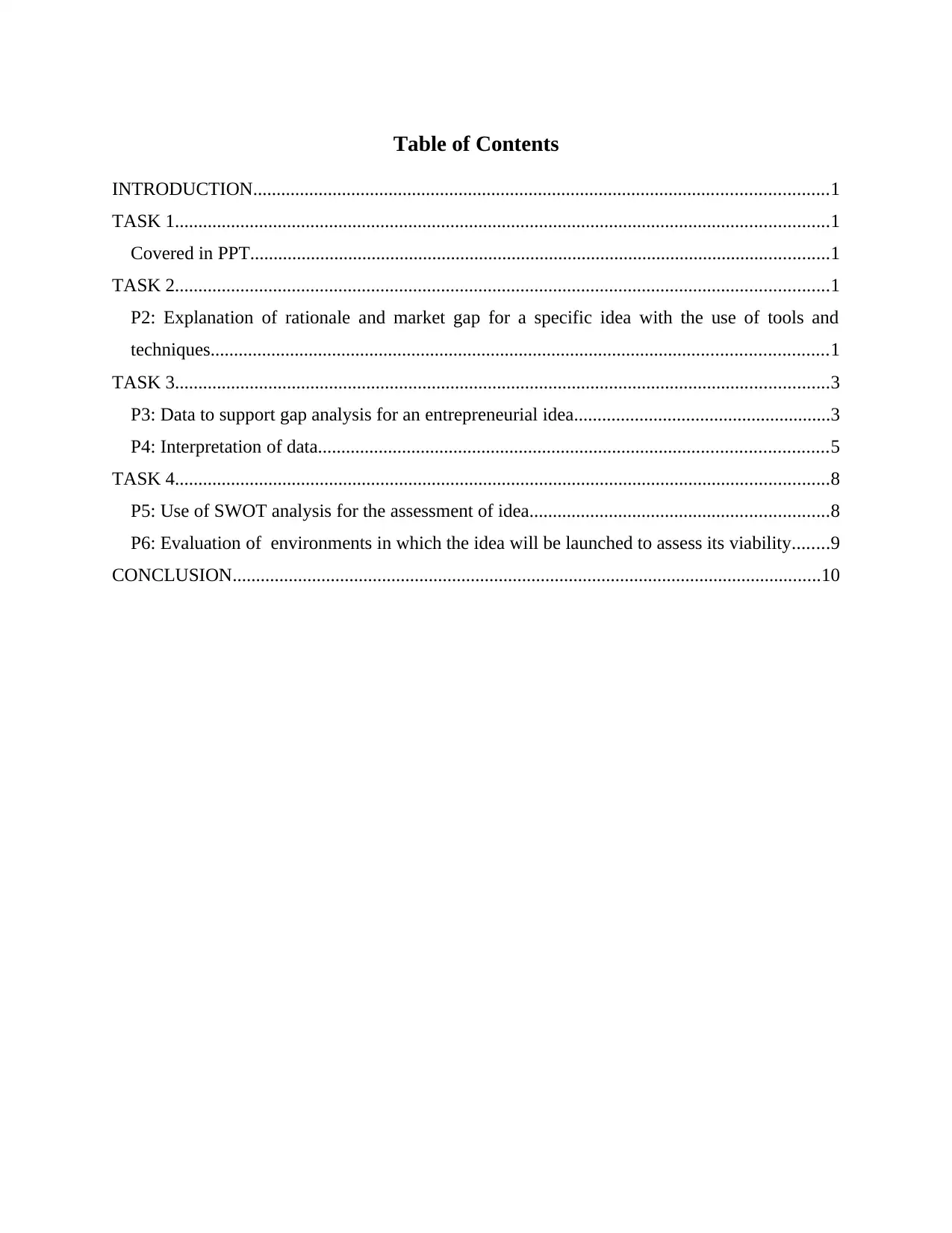
Table of Contents
INTRODUCTION...........................................................................................................................1
TASK 1............................................................................................................................................1
Covered in PPT............................................................................................................................1
TASK 2............................................................................................................................................1
P2: Explanation of rationale and market gap for a specific idea with the use of tools and
techniques....................................................................................................................................1
TASK 3............................................................................................................................................3
P3: Data to support gap analysis for an entrepreneurial idea.......................................................3
P4: Interpretation of data.............................................................................................................5
TASK 4............................................................................................................................................8
P5: Use of SWOT analysis for the assessment of idea................................................................8
P6: Evaluation of environments in which the idea will be launched to assess its viability........9
CONCLUSION..............................................................................................................................10
INTRODUCTION...........................................................................................................................1
TASK 1............................................................................................................................................1
Covered in PPT............................................................................................................................1
TASK 2............................................................................................................................................1
P2: Explanation of rationale and market gap for a specific idea with the use of tools and
techniques....................................................................................................................................1
TASK 3............................................................................................................................................3
P3: Data to support gap analysis for an entrepreneurial idea.......................................................3
P4: Interpretation of data.............................................................................................................5
TASK 4............................................................................................................................................8
P5: Use of SWOT analysis for the assessment of idea................................................................8
P6: Evaluation of environments in which the idea will be launched to assess its viability........9
CONCLUSION..............................................................................................................................10
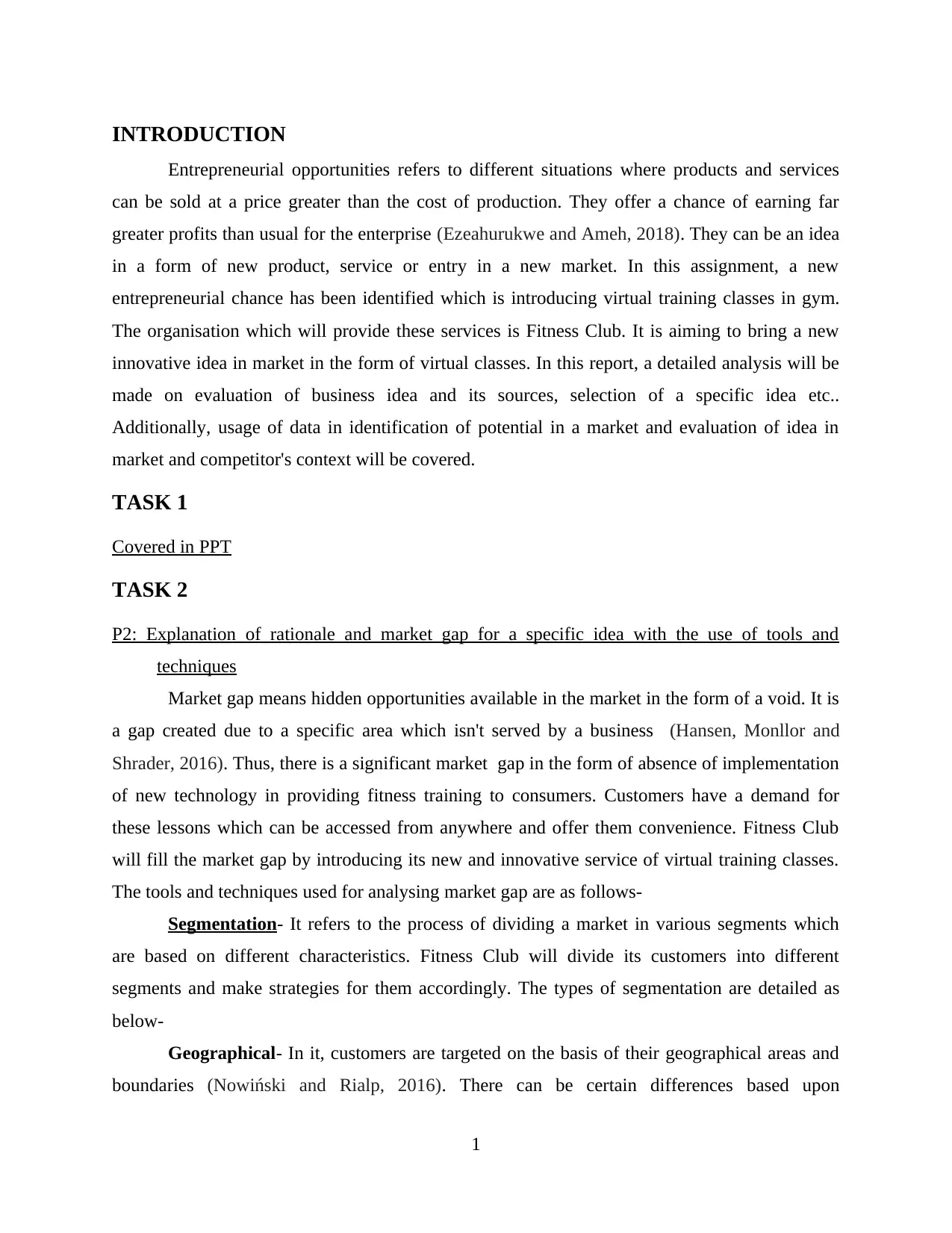
INTRODUCTION
Entrepreneurial opportunities refers to different situations where products and services
can be sold at a price greater than the cost of production. They offer a chance of earning far
greater profits than usual for the enterprise (Ezeahurukwe and Ameh, 2018). They can be an idea
in a form of new product, service or entry in a new market. In this assignment, a new
entrepreneurial chance has been identified which is introducing virtual training classes in gym.
The organisation which will provide these services is Fitness Club. It is aiming to bring a new
innovative idea in market in the form of virtual classes. In this report, a detailed analysis will be
made on evaluation of business idea and its sources, selection of a specific idea etc..
Additionally, usage of data in identification of potential in a market and evaluation of idea in
market and competitor's context will be covered.
TASK 1
Covered in PPT
TASK 2
P2: Explanation of rationale and market gap for a specific idea with the use of tools and
techniques
Market gap means hidden opportunities available in the market in the form of a void. It is
a gap created due to a specific area which isn't served by a business (Hansen, Monllor and
Shrader, 2016). Thus, there is a significant market gap in the form of absence of implementation
of new technology in providing fitness training to consumers. Customers have a demand for
these lessons which can be accessed from anywhere and offer them convenience. Fitness Club
will fill the market gap by introducing its new and innovative service of virtual training classes.
The tools and techniques used for analysing market gap are as follows-
Segmentation- It refers to the process of dividing a market in various segments which
are based on different characteristics. Fitness Club will divide its customers into different
segments and make strategies for them accordingly. The types of segmentation are detailed as
below-
Geographical- In it, customers are targeted on the basis of their geographical areas and
boundaries (Nowiński and Rialp, 2016). There can be certain differences based upon
1
Entrepreneurial opportunities refers to different situations where products and services
can be sold at a price greater than the cost of production. They offer a chance of earning far
greater profits than usual for the enterprise (Ezeahurukwe and Ameh, 2018). They can be an idea
in a form of new product, service or entry in a new market. In this assignment, a new
entrepreneurial chance has been identified which is introducing virtual training classes in gym.
The organisation which will provide these services is Fitness Club. It is aiming to bring a new
innovative idea in market in the form of virtual classes. In this report, a detailed analysis will be
made on evaluation of business idea and its sources, selection of a specific idea etc..
Additionally, usage of data in identification of potential in a market and evaluation of idea in
market and competitor's context will be covered.
TASK 1
Covered in PPT
TASK 2
P2: Explanation of rationale and market gap for a specific idea with the use of tools and
techniques
Market gap means hidden opportunities available in the market in the form of a void. It is
a gap created due to a specific area which isn't served by a business (Hansen, Monllor and
Shrader, 2016). Thus, there is a significant market gap in the form of absence of implementation
of new technology in providing fitness training to consumers. Customers have a demand for
these lessons which can be accessed from anywhere and offer them convenience. Fitness Club
will fill the market gap by introducing its new and innovative service of virtual training classes.
The tools and techniques used for analysing market gap are as follows-
Segmentation- It refers to the process of dividing a market in various segments which
are based on different characteristics. Fitness Club will divide its customers into different
segments and make strategies for them accordingly. The types of segmentation are detailed as
below-
Geographical- In it, customers are targeted on the basis of their geographical areas and
boundaries (Nowiński and Rialp, 2016). There can be certain differences based upon
1
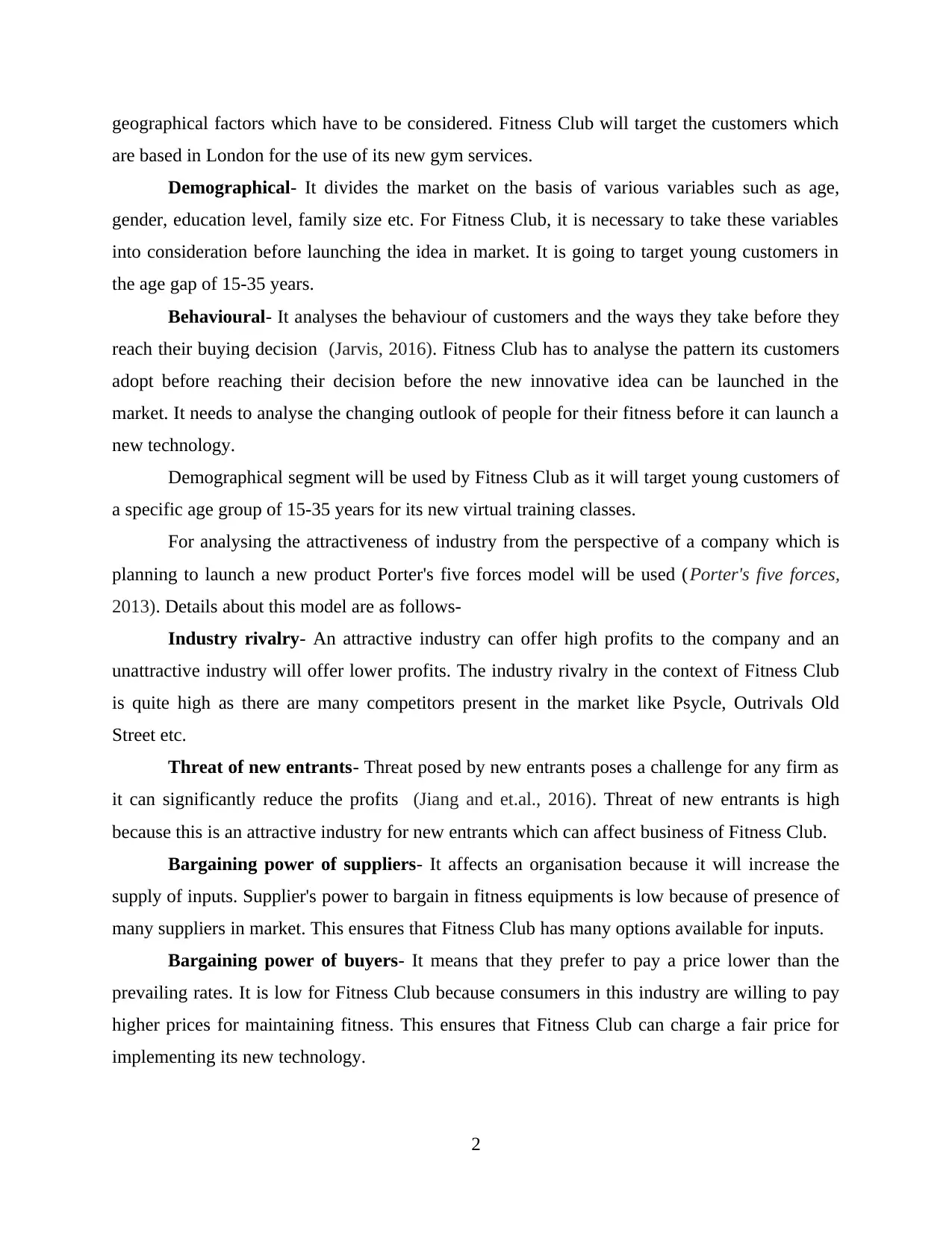
geographical factors which have to be considered. Fitness Club will target the customers which
are based in London for the use of its new gym services.
Demographical- It divides the market on the basis of various variables such as age,
gender, education level, family size etc. For Fitness Club, it is necessary to take these variables
into consideration before launching the idea in market. It is going to target young customers in
the age gap of 15-35 years.
Behavioural- It analyses the behaviour of customers and the ways they take before they
reach their buying decision (Jarvis, 2016). Fitness Club has to analyse the pattern its customers
adopt before reaching their decision before the new innovative idea can be launched in the
market. It needs to analyse the changing outlook of people for their fitness before it can launch a
new technology.
Demographical segment will be used by Fitness Club as it will target young customers of
a specific age group of 15-35 years for its new virtual training classes.
For analysing the attractiveness of industry from the perspective of a company which is
planning to launch a new product Porter's five forces model will be used (Porter's five forces,
2013). Details about this model are as follows-
Industry rivalry- An attractive industry can offer high profits to the company and an
unattractive industry will offer lower profits. The industry rivalry in the context of Fitness Club
is quite high as there are many competitors present in the market like Psycle, Outrivals Old
Street etc.
Threat of new entrants- Threat posed by new entrants poses a challenge for any firm as
it can significantly reduce the profits (Jiang and et.al., 2016). Threat of new entrants is high
because this is an attractive industry for new entrants which can affect business of Fitness Club.
Bargaining power of suppliers- It affects an organisation because it will increase the
supply of inputs. Supplier's power to bargain in fitness equipments is low because of presence of
many suppliers in market. This ensures that Fitness Club has many options available for inputs.
Bargaining power of buyers- It means that they prefer to pay a price lower than the
prevailing rates. It is low for Fitness Club because consumers in this industry are willing to pay
higher prices for maintaining fitness. This ensures that Fitness Club can charge a fair price for
implementing its new technology.
2
are based in London for the use of its new gym services.
Demographical- It divides the market on the basis of various variables such as age,
gender, education level, family size etc. For Fitness Club, it is necessary to take these variables
into consideration before launching the idea in market. It is going to target young customers in
the age gap of 15-35 years.
Behavioural- It analyses the behaviour of customers and the ways they take before they
reach their buying decision (Jarvis, 2016). Fitness Club has to analyse the pattern its customers
adopt before reaching their decision before the new innovative idea can be launched in the
market. It needs to analyse the changing outlook of people for their fitness before it can launch a
new technology.
Demographical segment will be used by Fitness Club as it will target young customers of
a specific age group of 15-35 years for its new virtual training classes.
For analysing the attractiveness of industry from the perspective of a company which is
planning to launch a new product Porter's five forces model will be used (Porter's five forces,
2013). Details about this model are as follows-
Industry rivalry- An attractive industry can offer high profits to the company and an
unattractive industry will offer lower profits. The industry rivalry in the context of Fitness Club
is quite high as there are many competitors present in the market like Psycle, Outrivals Old
Street etc.
Threat of new entrants- Threat posed by new entrants poses a challenge for any firm as
it can significantly reduce the profits (Jiang and et.al., 2016). Threat of new entrants is high
because this is an attractive industry for new entrants which can affect business of Fitness Club.
Bargaining power of suppliers- It affects an organisation because it will increase the
supply of inputs. Supplier's power to bargain in fitness equipments is low because of presence of
many suppliers in market. This ensures that Fitness Club has many options available for inputs.
Bargaining power of buyers- It means that they prefer to pay a price lower than the
prevailing rates. It is low for Fitness Club because consumers in this industry are willing to pay
higher prices for maintaining fitness. This ensures that Fitness Club can charge a fair price for
implementing its new technology.
2
Secure Best Marks with AI Grader
Need help grading? Try our AI Grader for instant feedback on your assignments.
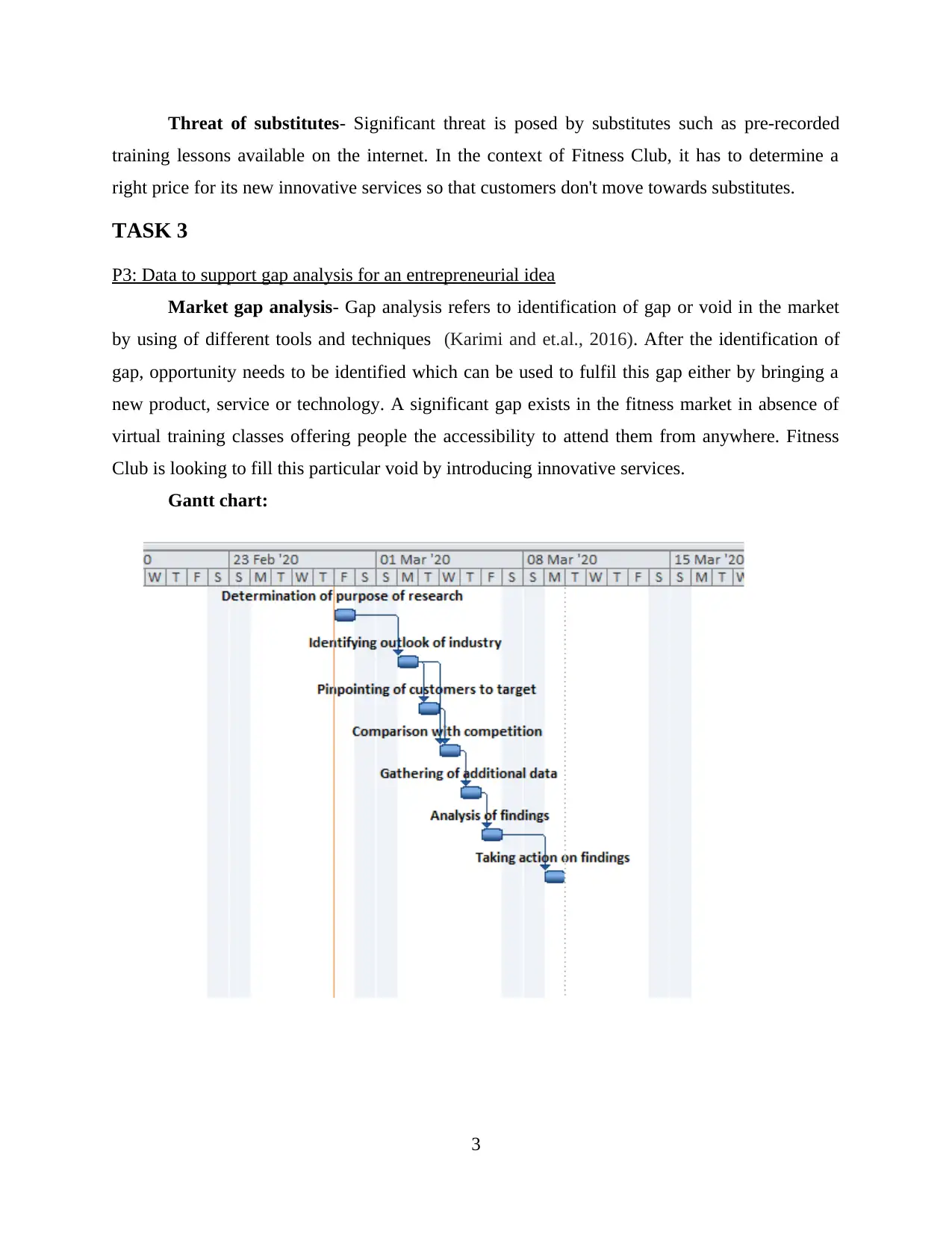
Threat of substitutes- Significant threat is posed by substitutes such as pre-recorded
training lessons available on the internet. In the context of Fitness Club, it has to determine a
right price for its new innovative services so that customers don't move towards substitutes.
TASK 3
P3: Data to support gap analysis for an entrepreneurial idea
Market gap analysis- Gap analysis refers to identification of gap or void in the market
by using of different tools and techniques (Karimi and et.al., 2016). After the identification of
gap, opportunity needs to be identified which can be used to fulfil this gap either by bringing a
new product, service or technology. A significant gap exists in the fitness market in absence of
virtual training classes offering people the accessibility to attend them from anywhere. Fitness
Club is looking to fill this particular void by introducing innovative services.
Gantt chart:
3
training lessons available on the internet. In the context of Fitness Club, it has to determine a
right price for its new innovative services so that customers don't move towards substitutes.
TASK 3
P3: Data to support gap analysis for an entrepreneurial idea
Market gap analysis- Gap analysis refers to identification of gap or void in the market
by using of different tools and techniques (Karimi and et.al., 2016). After the identification of
gap, opportunity needs to be identified which can be used to fulfil this gap either by bringing a
new product, service or technology. A significant gap exists in the fitness market in absence of
virtual training classes offering people the accessibility to attend them from anywhere. Fitness
Club is looking to fill this particular void by introducing innovative services.
Gantt chart:
3
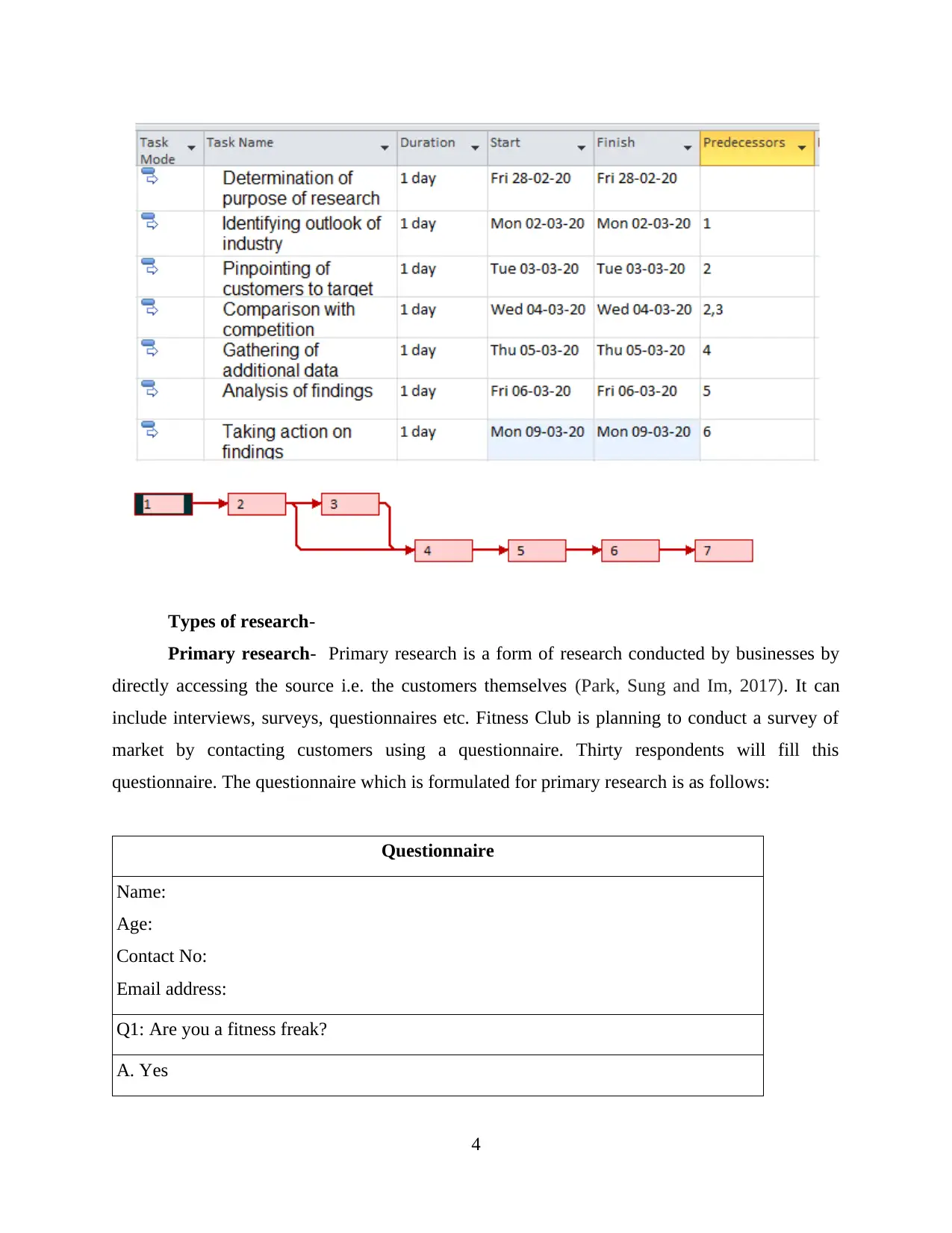
Types of research-
Primary research- Primary research is a form of research conducted by businesses by
directly accessing the source i.e. the customers themselves (Park, Sung and Im, 2017). It can
include interviews, surveys, questionnaires etc. Fitness Club is planning to conduct a survey of
market by contacting customers using a questionnaire. Thirty respondents will fill this
questionnaire. The questionnaire which is formulated for primary research is as follows:
Questionnaire
Name:
Age:
Contact No:
Email address:
Q1: Are you a fitness freak?
A. Yes
4
Primary research- Primary research is a form of research conducted by businesses by
directly accessing the source i.e. the customers themselves (Park, Sung and Im, 2017). It can
include interviews, surveys, questionnaires etc. Fitness Club is planning to conduct a survey of
market by contacting customers using a questionnaire. Thirty respondents will fill this
questionnaire. The questionnaire which is formulated for primary research is as follows:
Questionnaire
Name:
Age:
Contact No:
Email address:
Q1: Are you a fitness freak?
A. Yes
4
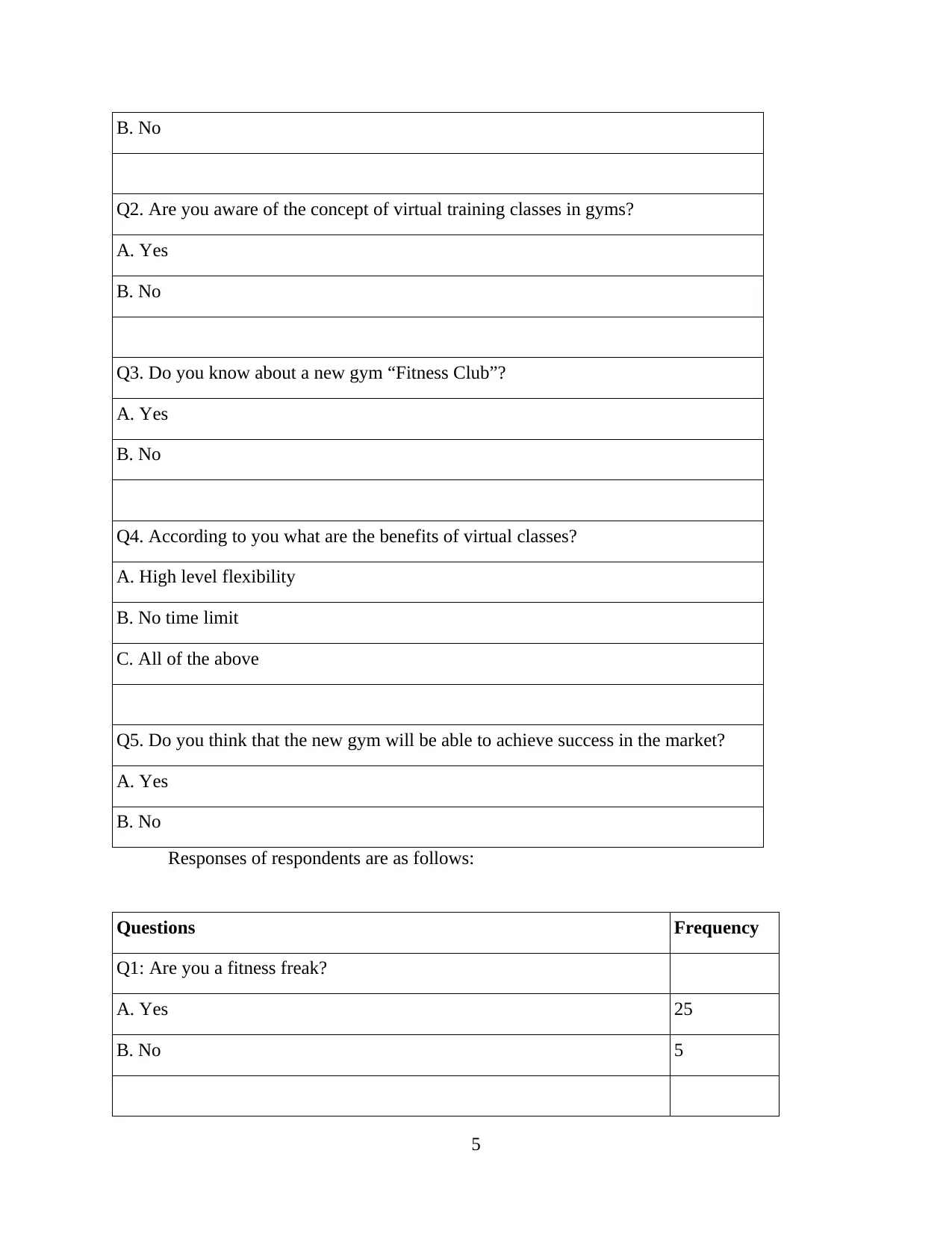
B. No
Q2. Are you aware of the concept of virtual training classes in gyms?
A. Yes
B. No
Q3. Do you know about a new gym “Fitness Club”?
A. Yes
B. No
Q4. According to you what are the benefits of virtual classes?
A. High level flexibility
B. No time limit
C. All of the above
Q5. Do you think that the new gym will be able to achieve success in the market?
A. Yes
B. No
Responses of respondents are as follows:
Questions Frequency
Q1: Are you a fitness freak?
A. Yes 25
B. No 5
5
Q2. Are you aware of the concept of virtual training classes in gyms?
A. Yes
B. No
Q3. Do you know about a new gym “Fitness Club”?
A. Yes
B. No
Q4. According to you what are the benefits of virtual classes?
A. High level flexibility
B. No time limit
C. All of the above
Q5. Do you think that the new gym will be able to achieve success in the market?
A. Yes
B. No
Responses of respondents are as follows:
Questions Frequency
Q1: Are you a fitness freak?
A. Yes 25
B. No 5
5
Paraphrase This Document
Need a fresh take? Get an instant paraphrase of this document with our AI Paraphraser
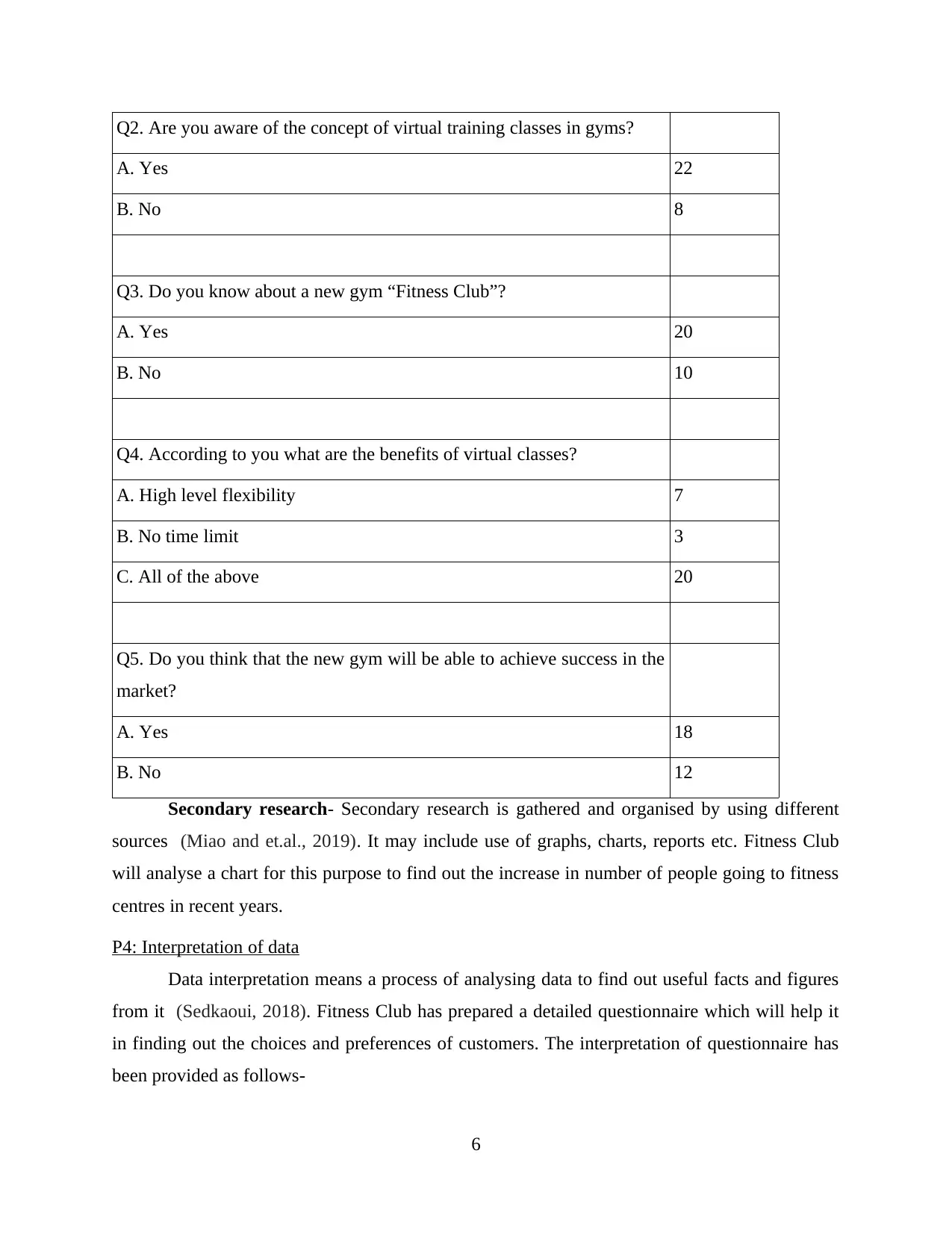
Q2. Are you aware of the concept of virtual training classes in gyms?
A. Yes 22
B. No 8
Q3. Do you know about a new gym “Fitness Club”?
A. Yes 20
B. No 10
Q4. According to you what are the benefits of virtual classes?
A. High level flexibility 7
B. No time limit 3
C. All of the above 20
Q5. Do you think that the new gym will be able to achieve success in the
market?
A. Yes 18
B. No 12
Secondary research- Secondary research is gathered and organised by using different
sources (Miao and et.al., 2019). It may include use of graphs, charts, reports etc. Fitness Club
will analyse a chart for this purpose to find out the increase in number of people going to fitness
centres in recent years.
P4: Interpretation of data
Data interpretation means a process of analysing data to find out useful facts and figures
from it (Sedkaoui, 2018). Fitness Club has prepared a detailed questionnaire which will help it
in finding out the choices and preferences of customers. The interpretation of questionnaire has
been provided as follows-
6
A. Yes 22
B. No 8
Q3. Do you know about a new gym “Fitness Club”?
A. Yes 20
B. No 10
Q4. According to you what are the benefits of virtual classes?
A. High level flexibility 7
B. No time limit 3
C. All of the above 20
Q5. Do you think that the new gym will be able to achieve success in the
market?
A. Yes 18
B. No 12
Secondary research- Secondary research is gathered and organised by using different
sources (Miao and et.al., 2019). It may include use of graphs, charts, reports etc. Fitness Club
will analyse a chart for this purpose to find out the increase in number of people going to fitness
centres in recent years.
P4: Interpretation of data
Data interpretation means a process of analysing data to find out useful facts and figures
from it (Sedkaoui, 2018). Fitness Club has prepared a detailed questionnaire which will help it
in finding out the choices and preferences of customers. The interpretation of questionnaire has
been provided as follows-
6
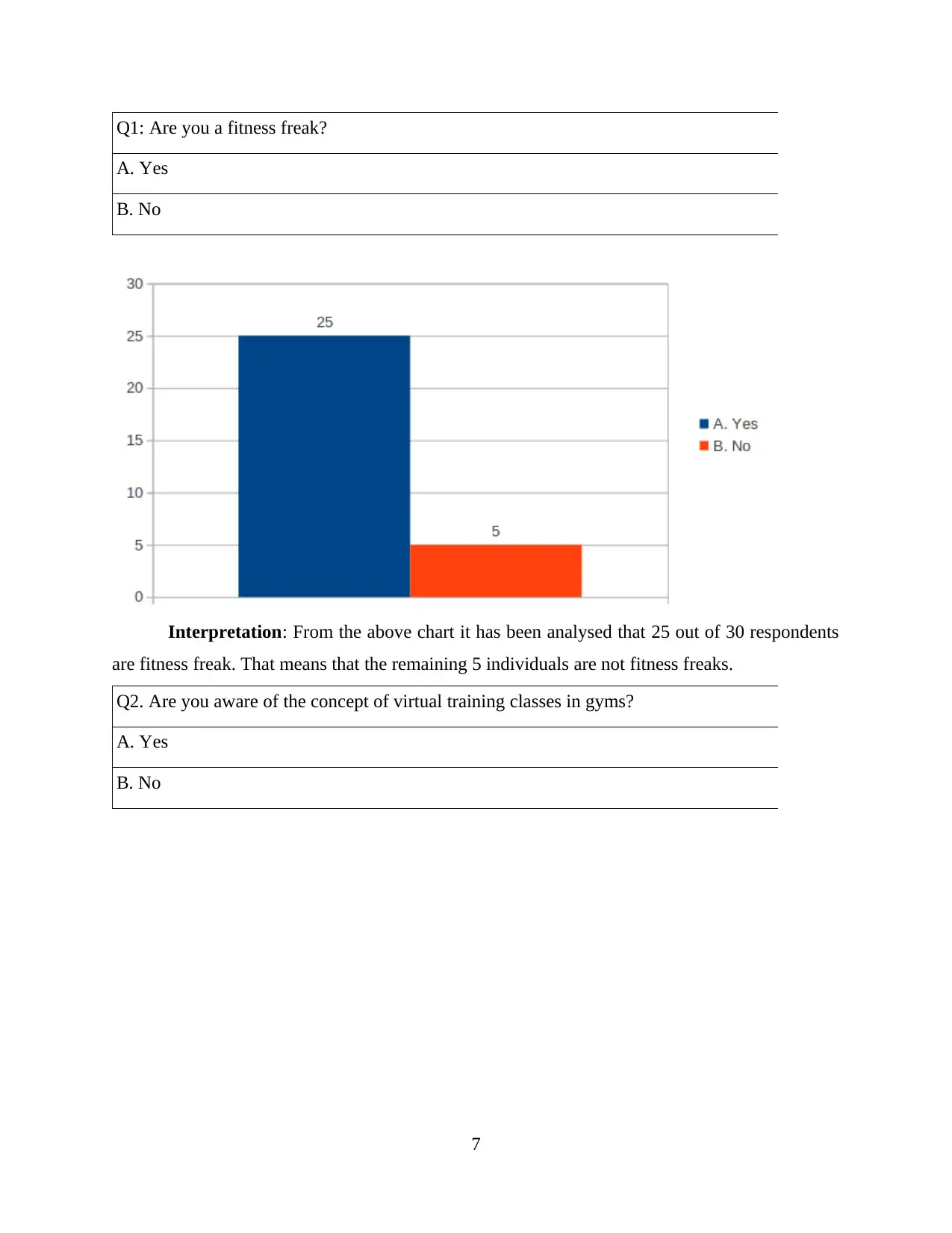
Q1: Are you a fitness freak?
A. Yes
B. No
Interpretation: From the above chart it has been analysed that 25 out of 30 respondents
are fitness freak. That means that the remaining 5 individuals are not fitness freaks.
Q2. Are you aware of the concept of virtual training classes in gyms?
A. Yes
B. No
7
A. Yes
B. No
Interpretation: From the above chart it has been analysed that 25 out of 30 respondents
are fitness freak. That means that the remaining 5 individuals are not fitness freaks.
Q2. Are you aware of the concept of virtual training classes in gyms?
A. Yes
B. No
7
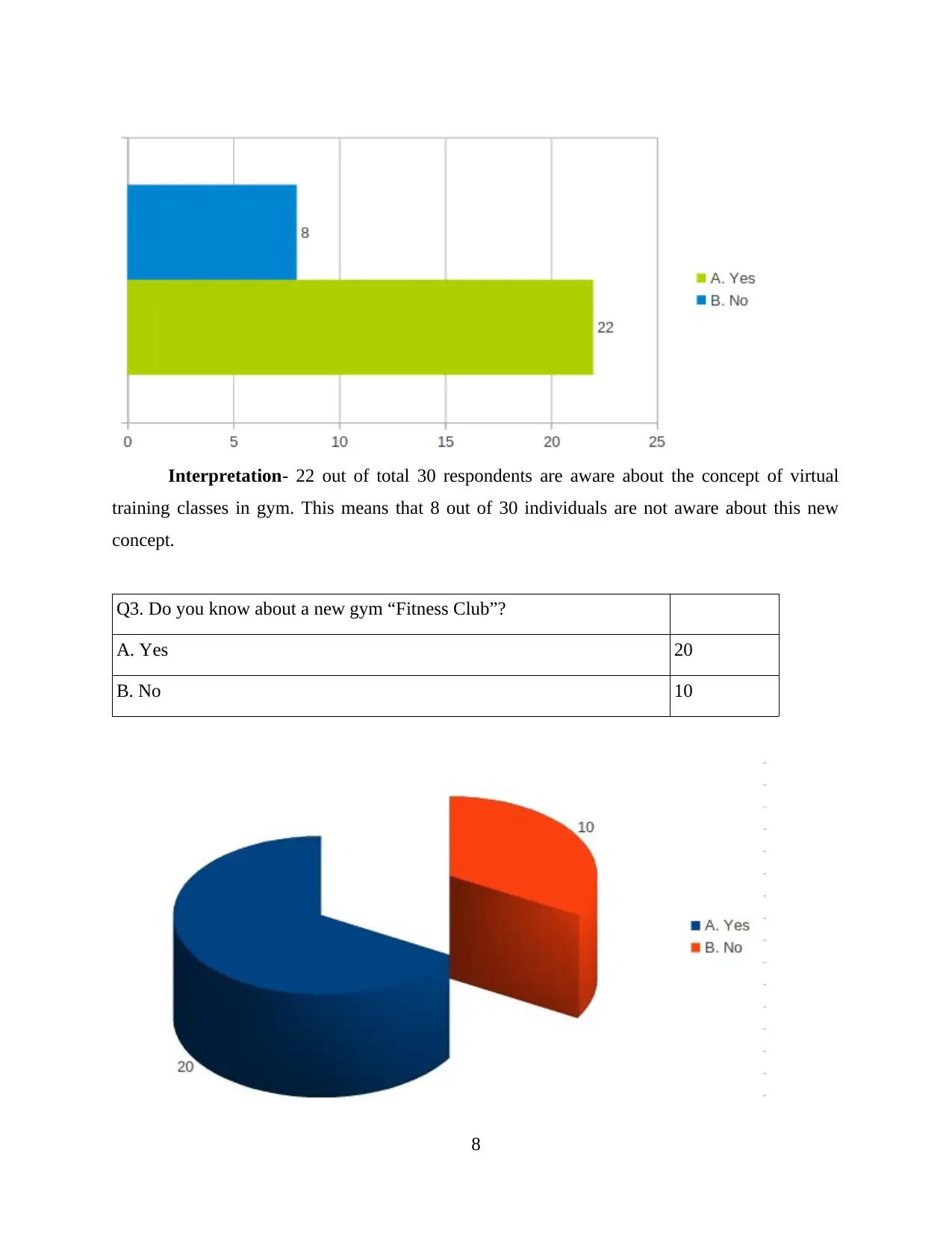
Interpretation- 22 out of total 30 respondents are aware about the concept of virtual
training classes in gym. This means that 8 out of 30 individuals are not aware about this new
concept.
Q3. Do you know about a new gym “Fitness Club”?
A. Yes 20
B. No 10
8
training classes in gym. This means that 8 out of 30 individuals are not aware about this new
concept.
Q3. Do you know about a new gym “Fitness Club”?
A. Yes 20
B. No 10
8
Secure Best Marks with AI Grader
Need help grading? Try our AI Grader for instant feedback on your assignments.
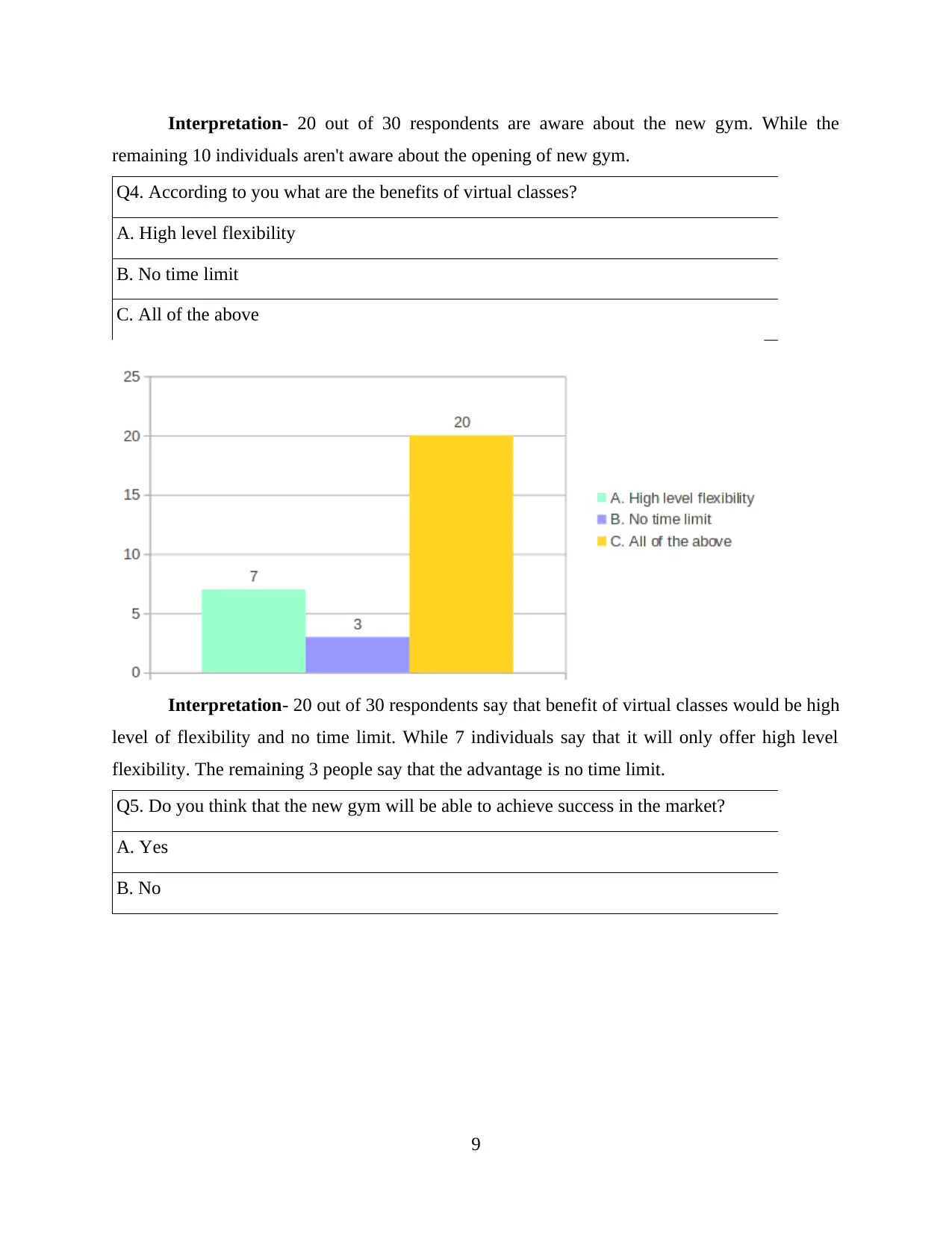
Interpretation- 20 out of 30 respondents are aware about the new gym. While the
remaining 10 individuals aren't aware about the opening of new gym.
Q4. According to you what are the benefits of virtual classes?
A. High level flexibility
B. No time limit
C. All of the above
Interpretation- 20 out of 30 respondents say that benefit of virtual classes would be high
level of flexibility and no time limit. While 7 individuals say that it will only offer high level
flexibility. The remaining 3 people say that the advantage is no time limit.
Q5. Do you think that the new gym will be able to achieve success in the market?
A. Yes
B. No
9
remaining 10 individuals aren't aware about the opening of new gym.
Q4. According to you what are the benefits of virtual classes?
A. High level flexibility
B. No time limit
C. All of the above
Interpretation- 20 out of 30 respondents say that benefit of virtual classes would be high
level of flexibility and no time limit. While 7 individuals say that it will only offer high level
flexibility. The remaining 3 people say that the advantage is no time limit.
Q5. Do you think that the new gym will be able to achieve success in the market?
A. Yes
B. No
9
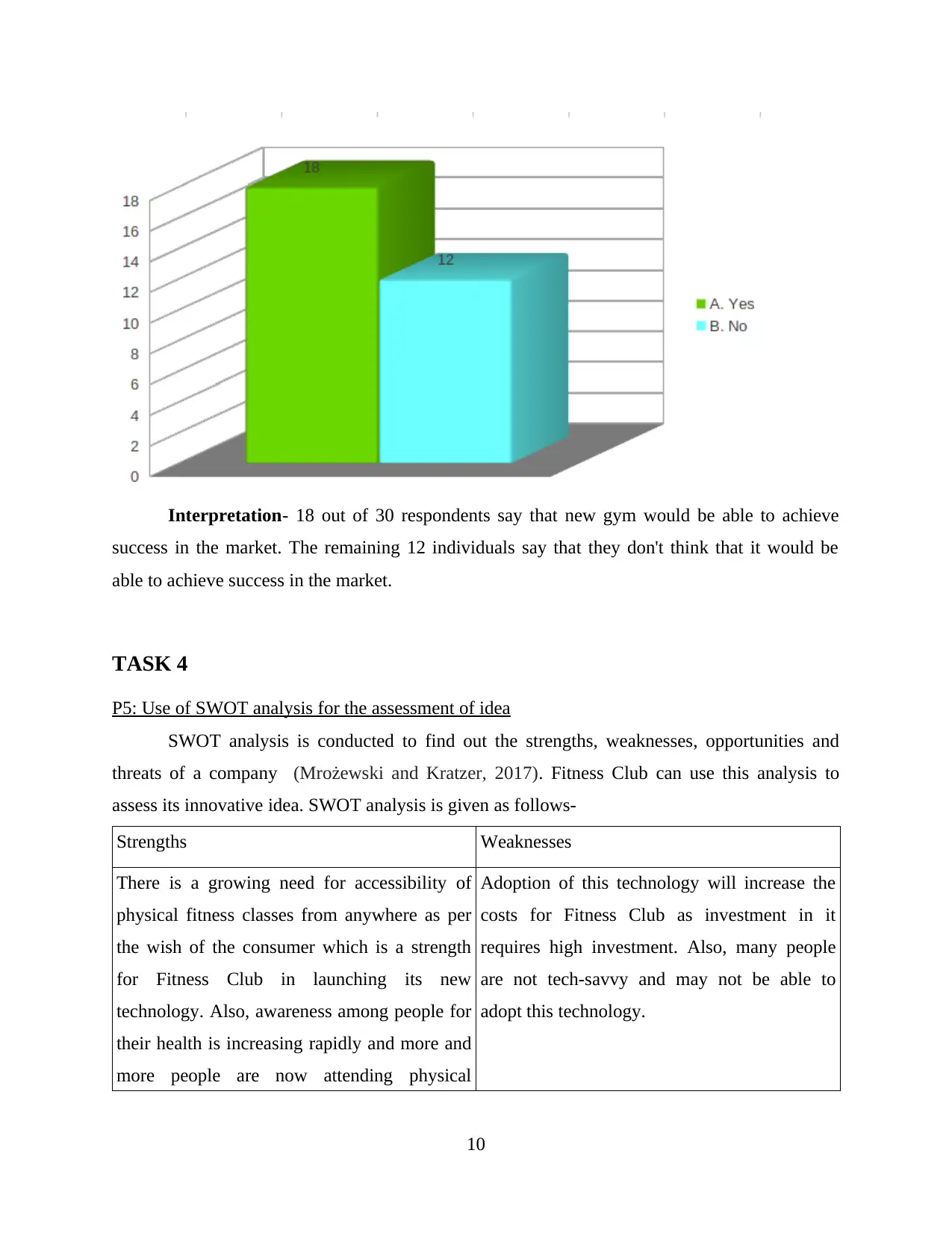
Interpretation- 18 out of 30 respondents say that new gym would be able to achieve
success in the market. The remaining 12 individuals say that they don't think that it would be
able to achieve success in the market.
TASK 4
P5: Use of SWOT analysis for the assessment of idea
SWOT analysis is conducted to find out the strengths, weaknesses, opportunities and
threats of a company (Mrożewski and Kratzer, 2017). Fitness Club can use this analysis to
assess its innovative idea. SWOT analysis is given as follows-
Strengths Weaknesses
There is a growing need for accessibility of
physical fitness classes from anywhere as per
the wish of the consumer which is a strength
for Fitness Club in launching its new
technology. Also, awareness among people for
their health is increasing rapidly and more and
more people are now attending physical
Adoption of this technology will increase the
costs for Fitness Club as investment in it
requires high investment. Also, many people
are not tech-savvy and may not be able to
adopt this technology.
10
success in the market. The remaining 12 individuals say that they don't think that it would be
able to achieve success in the market.
TASK 4
P5: Use of SWOT analysis for the assessment of idea
SWOT analysis is conducted to find out the strengths, weaknesses, opportunities and
threats of a company (Mrożewski and Kratzer, 2017). Fitness Club can use this analysis to
assess its innovative idea. SWOT analysis is given as follows-
Strengths Weaknesses
There is a growing need for accessibility of
physical fitness classes from anywhere as per
the wish of the consumer which is a strength
for Fitness Club in launching its new
technology. Also, awareness among people for
their health is increasing rapidly and more and
more people are now attending physical
Adoption of this technology will increase the
costs for Fitness Club as investment in it
requires high investment. Also, many people
are not tech-savvy and may not be able to
adopt this technology.
10
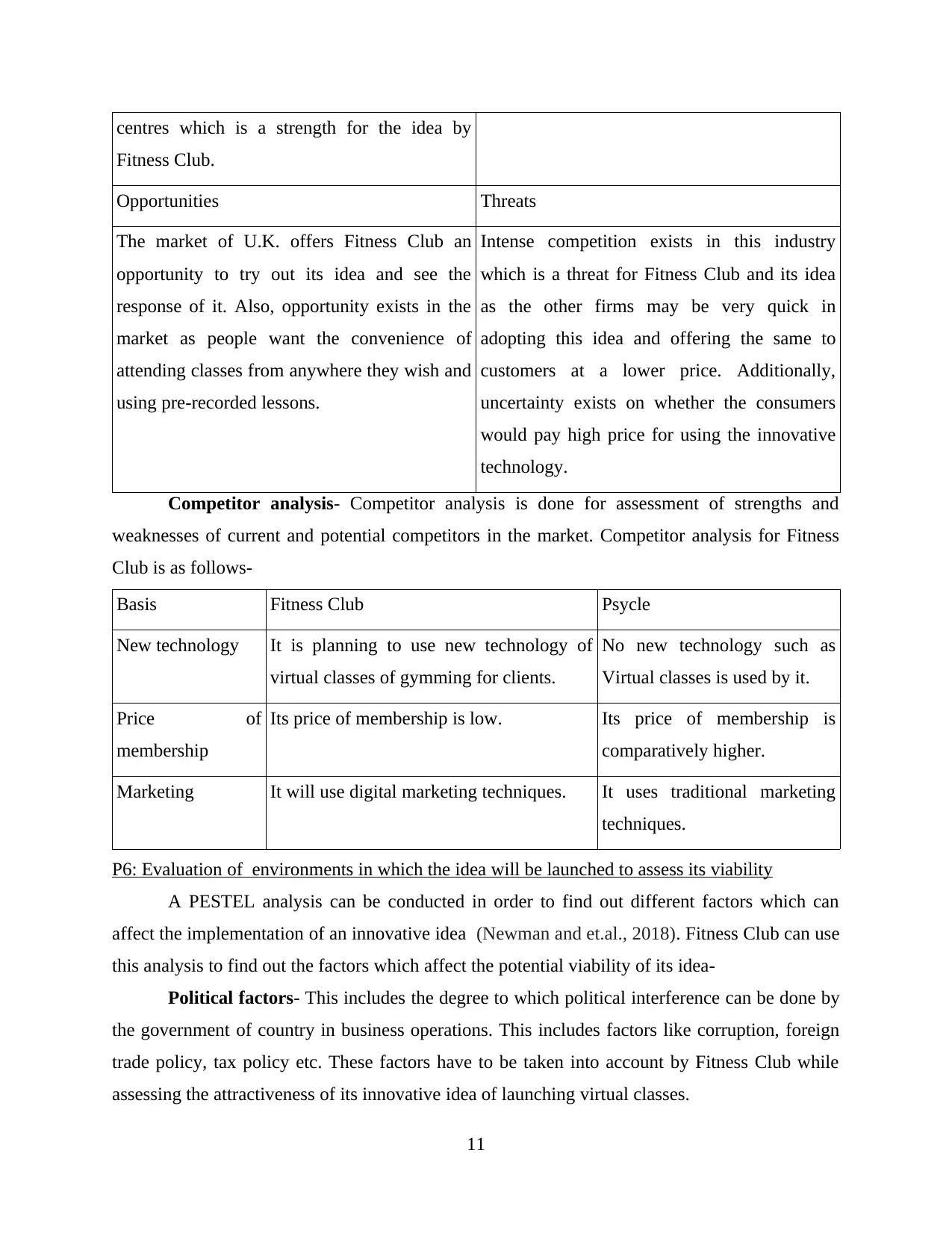
centres which is a strength for the idea by
Fitness Club.
Opportunities Threats
The market of U.K. offers Fitness Club an
opportunity to try out its idea and see the
response of it. Also, opportunity exists in the
market as people want the convenience of
attending classes from anywhere they wish and
using pre-recorded lessons.
Intense competition exists in this industry
which is a threat for Fitness Club and its idea
as the other firms may be very quick in
adopting this idea and offering the same to
customers at a lower price. Additionally,
uncertainty exists on whether the consumers
would pay high price for using the innovative
technology.
Competitor analysis- Competitor analysis is done for assessment of strengths and
weaknesses of current and potential competitors in the market. Competitor analysis for Fitness
Club is as follows-
Basis Fitness Club Psycle
New technology It is planning to use new technology of
virtual classes of gymming for clients.
No new technology such as
Virtual classes is used by it.
Price of
membership
Its price of membership is low. Its price of membership is
comparatively higher.
Marketing It will use digital marketing techniques. It uses traditional marketing
techniques.
P6: Evaluation of environments in which the idea will be launched to assess its viability
A PESTEL analysis can be conducted in order to find out different factors which can
affect the implementation of an innovative idea (Newman and et.al., 2018). Fitness Club can use
this analysis to find out the factors which affect the potential viability of its idea-
Political factors- This includes the degree to which political interference can be done by
the government of country in business operations. This includes factors like corruption, foreign
trade policy, tax policy etc. These factors have to be taken into account by Fitness Club while
assessing the attractiveness of its innovative idea of launching virtual classes.
11
Fitness Club.
Opportunities Threats
The market of U.K. offers Fitness Club an
opportunity to try out its idea and see the
response of it. Also, opportunity exists in the
market as people want the convenience of
attending classes from anywhere they wish and
using pre-recorded lessons.
Intense competition exists in this industry
which is a threat for Fitness Club and its idea
as the other firms may be very quick in
adopting this idea and offering the same to
customers at a lower price. Additionally,
uncertainty exists on whether the consumers
would pay high price for using the innovative
technology.
Competitor analysis- Competitor analysis is done for assessment of strengths and
weaknesses of current and potential competitors in the market. Competitor analysis for Fitness
Club is as follows-
Basis Fitness Club Psycle
New technology It is planning to use new technology of
virtual classes of gymming for clients.
No new technology such as
Virtual classes is used by it.
Price of
membership
Its price of membership is low. Its price of membership is
comparatively higher.
Marketing It will use digital marketing techniques. It uses traditional marketing
techniques.
P6: Evaluation of environments in which the idea will be launched to assess its viability
A PESTEL analysis can be conducted in order to find out different factors which can
affect the implementation of an innovative idea (Newman and et.al., 2018). Fitness Club can use
this analysis to find out the factors which affect the potential viability of its idea-
Political factors- This includes the degree to which political interference can be done by
the government of country in business operations. This includes factors like corruption, foreign
trade policy, tax policy etc. These factors have to be taken into account by Fitness Club while
assessing the attractiveness of its innovative idea of launching virtual classes.
11
Paraphrase This Document
Need a fresh take? Get an instant paraphrase of this document with our AI Paraphraser
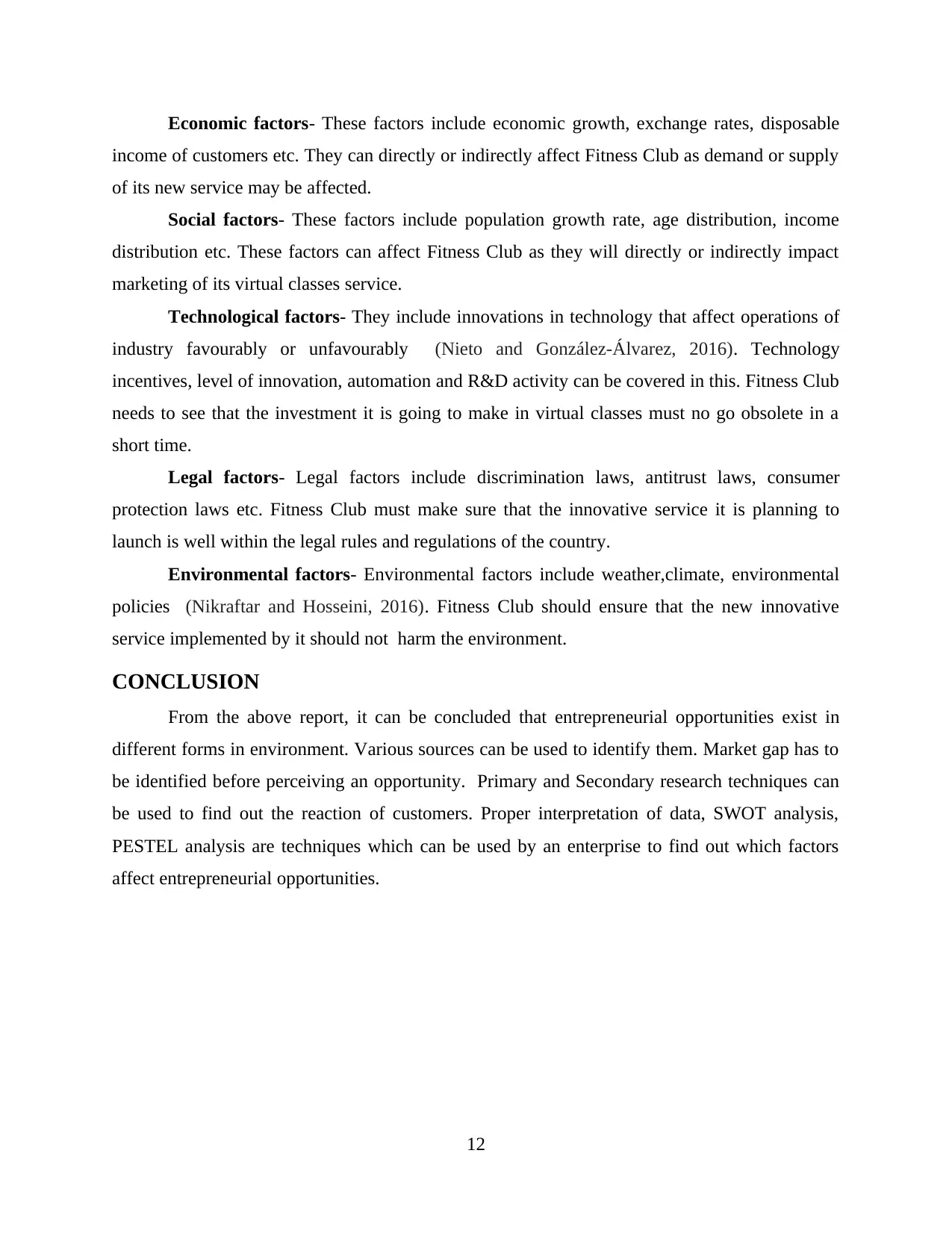
Economic factors- These factors include economic growth, exchange rates, disposable
income of customers etc. They can directly or indirectly affect Fitness Club as demand or supply
of its new service may be affected.
Social factors- These factors include population growth rate, age distribution, income
distribution etc. These factors can affect Fitness Club as they will directly or indirectly impact
marketing of its virtual classes service.
Technological factors- They include innovations in technology that affect operations of
industry favourably or unfavourably (Nieto and González-Álvarez, 2016). Technology
incentives, level of innovation, automation and R&D activity can be covered in this. Fitness Club
needs to see that the investment it is going to make in virtual classes must no go obsolete in a
short time.
Legal factors- Legal factors include discrimination laws, antitrust laws, consumer
protection laws etc. Fitness Club must make sure that the innovative service it is planning to
launch is well within the legal rules and regulations of the country.
Environmental factors- Environmental factors include weather,climate, environmental
policies (Nikraftar and Hosseini, 2016). Fitness Club should ensure that the new innovative
service implemented by it should not harm the environment.
CONCLUSION
From the above report, it can be concluded that entrepreneurial opportunities exist in
different forms in environment. Various sources can be used to identify them. Market gap has to
be identified before perceiving an opportunity. Primary and Secondary research techniques can
be used to find out the reaction of customers. Proper interpretation of data, SWOT analysis,
PESTEL analysis are techniques which can be used by an enterprise to find out which factors
affect entrepreneurial opportunities.
12
income of customers etc. They can directly or indirectly affect Fitness Club as demand or supply
of its new service may be affected.
Social factors- These factors include population growth rate, age distribution, income
distribution etc. These factors can affect Fitness Club as they will directly or indirectly impact
marketing of its virtual classes service.
Technological factors- They include innovations in technology that affect operations of
industry favourably or unfavourably (Nieto and González-Álvarez, 2016). Technology
incentives, level of innovation, automation and R&D activity can be covered in this. Fitness Club
needs to see that the investment it is going to make in virtual classes must no go obsolete in a
short time.
Legal factors- Legal factors include discrimination laws, antitrust laws, consumer
protection laws etc. Fitness Club must make sure that the innovative service it is planning to
launch is well within the legal rules and regulations of the country.
Environmental factors- Environmental factors include weather,climate, environmental
policies (Nikraftar and Hosseini, 2016). Fitness Club should ensure that the new innovative
service implemented by it should not harm the environment.
CONCLUSION
From the above report, it can be concluded that entrepreneurial opportunities exist in
different forms in environment. Various sources can be used to identify them. Market gap has to
be identified before perceiving an opportunity. Primary and Secondary research techniques can
be used to find out the reaction of customers. Proper interpretation of data, SWOT analysis,
PESTEL analysis are techniques which can be used by an enterprise to find out which factors
affect entrepreneurial opportunities.
12
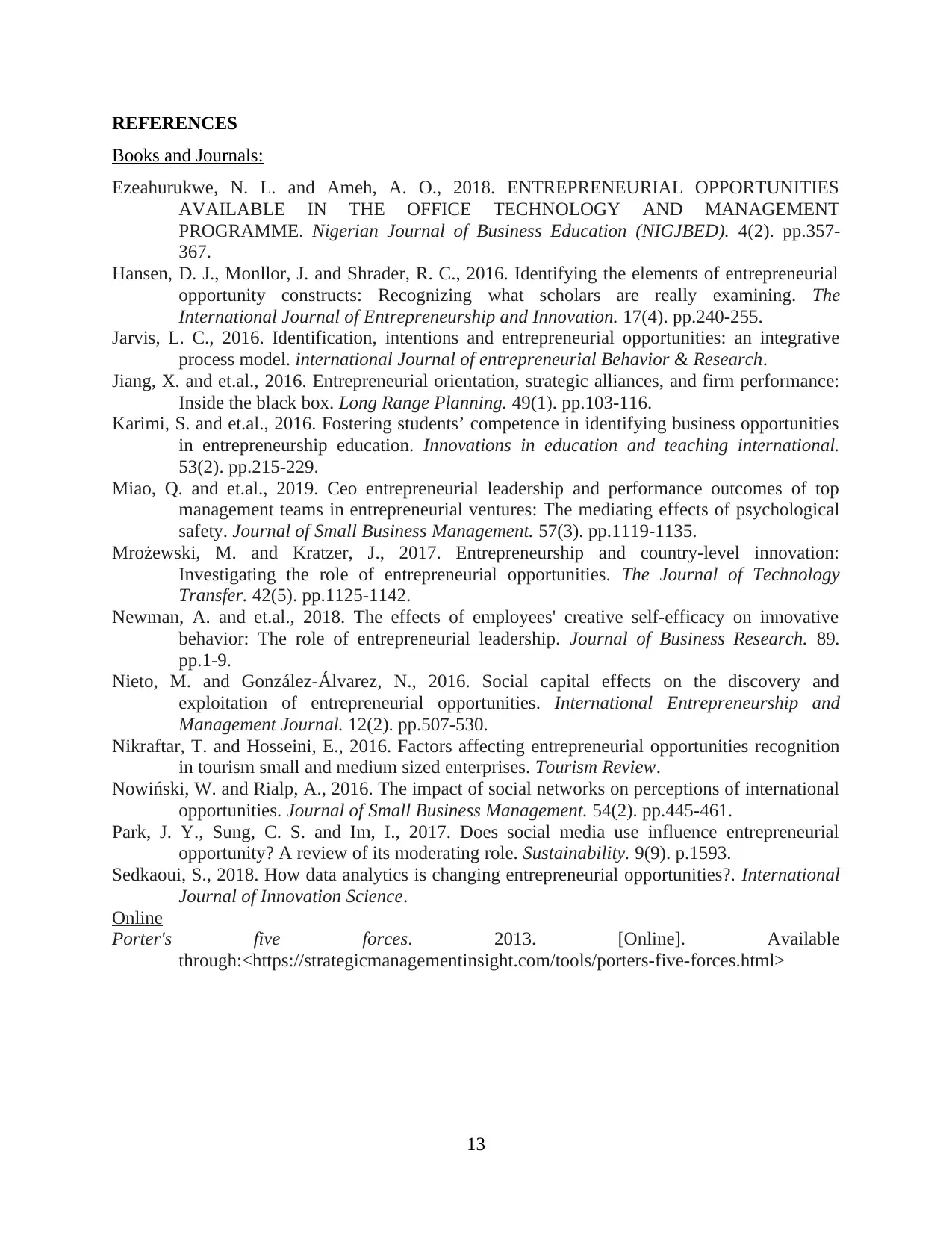
REFERENCES
Books and Journals:
Ezeahurukwe, N. L. and Ameh, A. O., 2018. ENTREPRENEURIAL OPPORTUNITIES
AVAILABLE IN THE OFFICE TECHNOLOGY AND MANAGEMENT
PROGRAMME. Nigerian Journal of Business Education (NIGJBED). 4(2). pp.357-
367.
Hansen, D. J., Monllor, J. and Shrader, R. C., 2016. Identifying the elements of entrepreneurial
opportunity constructs: Recognizing what scholars are really examining. The
International Journal of Entrepreneurship and Innovation. 17(4). pp.240-255.
Jarvis, L. C., 2016. Identification, intentions and entrepreneurial opportunities: an integrative
process model. international Journal of entrepreneurial Behavior & Research.
Jiang, X. and et.al., 2016. Entrepreneurial orientation, strategic alliances, and firm performance:
Inside the black box. Long Range Planning. 49(1). pp.103-116.
Karimi, S. and et.al., 2016. Fostering students’ competence in identifying business opportunities
in entrepreneurship education. Innovations in education and teaching international.
53(2). pp.215-229.
Miao, Q. and et.al., 2019. Ceo entrepreneurial leadership and performance outcomes of top
management teams in entrepreneurial ventures: The mediating effects of psychological
safety. Journal of Small Business Management. 57(3). pp.1119-1135.
Mrożewski, M. and Kratzer, J., 2017. Entrepreneurship and country-level innovation:
Investigating the role of entrepreneurial opportunities. The Journal of Technology
Transfer. 42(5). pp.1125-1142.
Newman, A. and et.al., 2018. The effects of employees' creative self-efficacy on innovative
behavior: The role of entrepreneurial leadership. Journal of Business Research. 89.
pp.1-9.
Nieto, M. and González-Álvarez, N., 2016. Social capital effects on the discovery and
exploitation of entrepreneurial opportunities. International Entrepreneurship and
Management Journal. 12(2). pp.507-530.
Nikraftar, T. and Hosseini, E., 2016. Factors affecting entrepreneurial opportunities recognition
in tourism small and medium sized enterprises. Tourism Review.
Nowiński, W. and Rialp, A., 2016. The impact of social networks on perceptions of international
opportunities. Journal of Small Business Management. 54(2). pp.445-461.
Park, J. Y., Sung, C. S. and Im, I., 2017. Does social media use influence entrepreneurial
opportunity? A review of its moderating role. Sustainability. 9(9). p.1593.
Sedkaoui, S., 2018. How data analytics is changing entrepreneurial opportunities?. International
Journal of Innovation Science.
Online
Porter's five forces. 2013. [Online]. Available
through:<https://strategicmanagementinsight.com/tools/porters-five-forces.html>
13
Books and Journals:
Ezeahurukwe, N. L. and Ameh, A. O., 2018. ENTREPRENEURIAL OPPORTUNITIES
AVAILABLE IN THE OFFICE TECHNOLOGY AND MANAGEMENT
PROGRAMME. Nigerian Journal of Business Education (NIGJBED). 4(2). pp.357-
367.
Hansen, D. J., Monllor, J. and Shrader, R. C., 2016. Identifying the elements of entrepreneurial
opportunity constructs: Recognizing what scholars are really examining. The
International Journal of Entrepreneurship and Innovation. 17(4). pp.240-255.
Jarvis, L. C., 2016. Identification, intentions and entrepreneurial opportunities: an integrative
process model. international Journal of entrepreneurial Behavior & Research.
Jiang, X. and et.al., 2016. Entrepreneurial orientation, strategic alliances, and firm performance:
Inside the black box. Long Range Planning. 49(1). pp.103-116.
Karimi, S. and et.al., 2016. Fostering students’ competence in identifying business opportunities
in entrepreneurship education. Innovations in education and teaching international.
53(2). pp.215-229.
Miao, Q. and et.al., 2019. Ceo entrepreneurial leadership and performance outcomes of top
management teams in entrepreneurial ventures: The mediating effects of psychological
safety. Journal of Small Business Management. 57(3). pp.1119-1135.
Mrożewski, M. and Kratzer, J., 2017. Entrepreneurship and country-level innovation:
Investigating the role of entrepreneurial opportunities. The Journal of Technology
Transfer. 42(5). pp.1125-1142.
Newman, A. and et.al., 2018. The effects of employees' creative self-efficacy on innovative
behavior: The role of entrepreneurial leadership. Journal of Business Research. 89.
pp.1-9.
Nieto, M. and González-Álvarez, N., 2016. Social capital effects on the discovery and
exploitation of entrepreneurial opportunities. International Entrepreneurship and
Management Journal. 12(2). pp.507-530.
Nikraftar, T. and Hosseini, E., 2016. Factors affecting entrepreneurial opportunities recognition
in tourism small and medium sized enterprises. Tourism Review.
Nowiński, W. and Rialp, A., 2016. The impact of social networks on perceptions of international
opportunities. Journal of Small Business Management. 54(2). pp.445-461.
Park, J. Y., Sung, C. S. and Im, I., 2017. Does social media use influence entrepreneurial
opportunity? A review of its moderating role. Sustainability. 9(9). p.1593.
Sedkaoui, S., 2018. How data analytics is changing entrepreneurial opportunities?. International
Journal of Innovation Science.
Online
Porter's five forces. 2013. [Online]. Available
through:<https://strategicmanagementinsight.com/tools/porters-five-forces.html>
13
1 out of 15
Related Documents
Your All-in-One AI-Powered Toolkit for Academic Success.
+13062052269
info@desklib.com
Available 24*7 on WhatsApp / Email
![[object Object]](/_next/static/media/star-bottom.7253800d.svg)
Unlock your academic potential
© 2024 | Zucol Services PVT LTD | All rights reserved.





